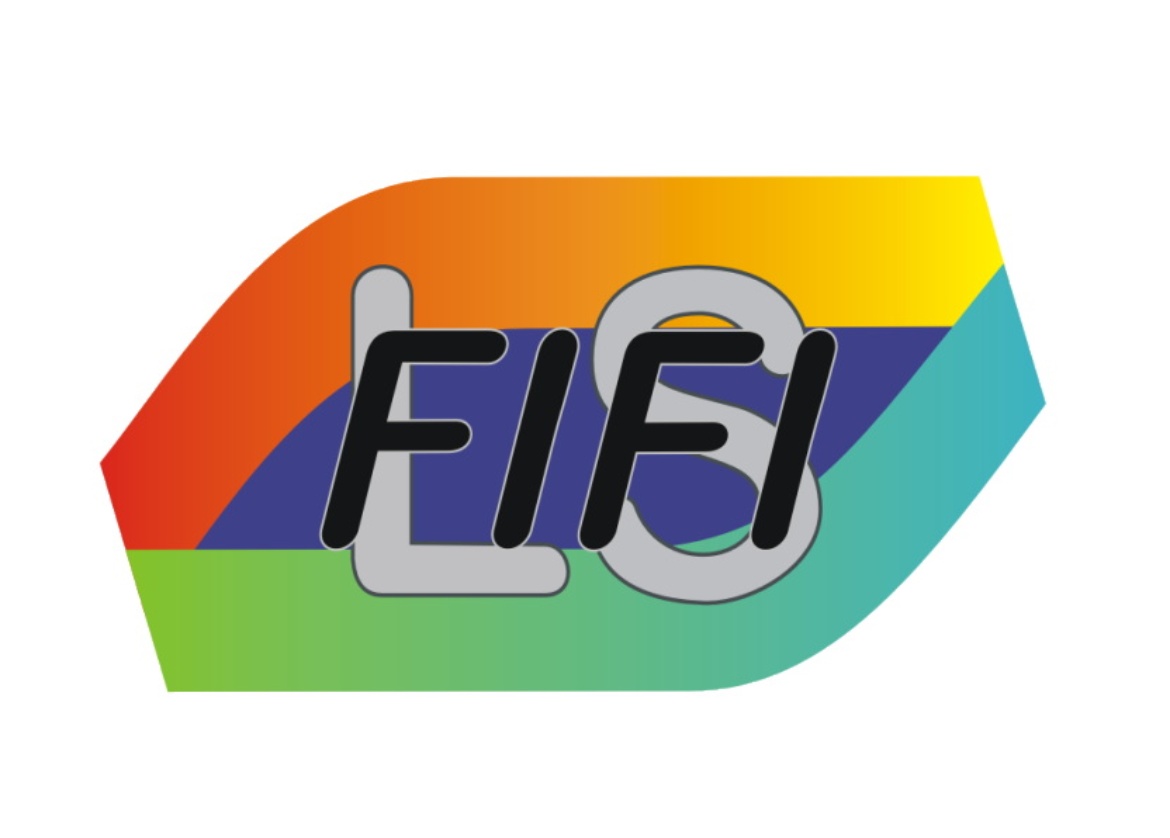What is FIFI-LS?
FIFI-LS is a first generation Science Instrument for the flying infrared observatory SOFIA. The Stratospheric Observatory for Infrared Astronomy is a highly modified Boeing 747 airplane. It carries a 2.7 m telescope to high altitudes to enable astronomical observations of infrared radiation that are not possible form the Earth’s surface. It was developed and mainly integrated at the Max Planck Institute for Extraterrestrial Physics in Garching.
FIFI-LS stands for Field- Imaging Far- Infrared Line- Spectrometer. The instrument can record spectra for each pixel of its 5x5 field of view per detector simultaneously. In addition, FIFI-LS has two independent wavelength channels. The incoming signal is split up in two channels:
- the short wavelength channel from 51 to 120 microns
- the long wavelength channel from 115 to 203 microns.
This range contains a lot of astronomically interesting spectral lines. Measuring the intensities of these lines in specific areas of the sky – e.g. in the spiral arms of a galaxy – returns information on the physical properties (e.g. pressure, temperature) or the chemical composition of these areas. This data is the basis to improve our knowledge of the formation of stars and galaxies.
Principal Investigator
Alfred Krabbe (IRS)
Co-investigators
Norbert Geis (MPE)
Randolf Klein (USRA)
Leslie Looney (UIUC)
Albrecht Poglitsch (MPE)
Hendrik Linz representing Thomas Henning (MPIA)
Collaborators
Simon Beckmann (IRS)
Aaron Bryant (IRS)
Sebastian Colditz (IRS)
Christian Fischer (IRS)
Fabio Fumi (IRS)
Rainer Hönle (IRS)
Walfried Raab (MPE)
Felix Rebell (IRS)
Maureen Savage (USRA)
IRS - Institut für Raumfahrtsysteme
MPE - Max-Planck-Institut für extraterrestrische Physik
MPIA - Max-Planck-Institut für Astronomie
UIUC - University of Illinois
USRA - Universities Space Research Association

From left to right: Felix Rebell, Alfred Krabbe, Sebastian Colditz, Maureen Savage, Leslie Looney, Randolf Klein, Fabio Fumi, Christian Fischer
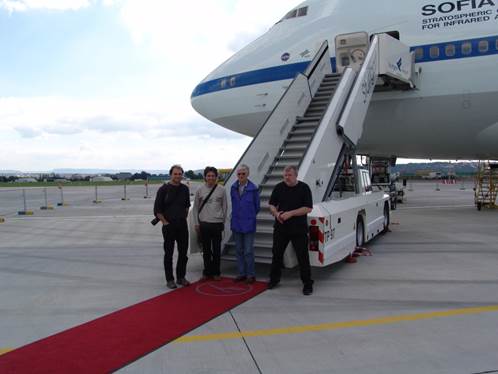
From left to right: Walfried Raab, Rainer Hönle, Albrecht Poglitsch, Norbert Geis
General Information about FIFI-LS
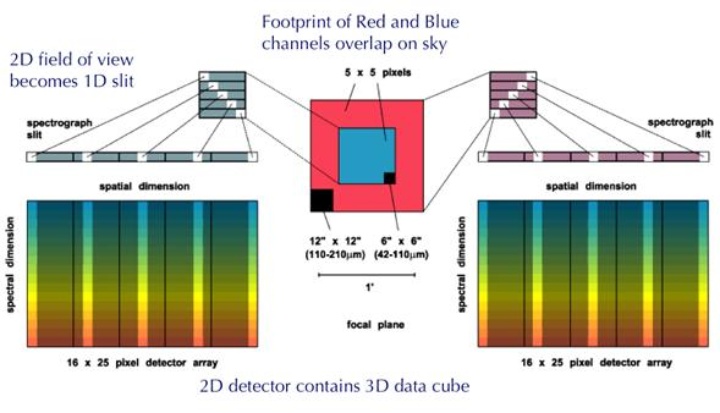
FIFI-LS (Field Imaging Far-infrared Line Spectrometer) is an imaging spectrograph, comprised of two medium resolution (R~2200) grating spectrometers that feed two 16x25 pixel detector arrays, enabling simultaneous line observations within two wavelengths ranges (51-120 μm and 115-203 μm). An image slicer provides spatial information, redistributing the field-of-view along 25 entrance slits. FIFI-LS will offer instantaneous coverage at 50 - 240 km/s resolution over a velocity range of 1500-3000 km/s around selected lines for each of the 25 spatial pixels. See Figure 1 for details.
FIFI-LS covers a wavelengths range similar to that covered by two other SOFIA first generation instruments, the heterodyne spectrometer GREAT and the FIR camera HAWC (Figure 2). FIFI-LS’ spectral resolution is pretty much in the middle between those two providing spectral resolutions about 3 orders of magnitude lower and higher, respectively FIFI-LS’ imaging capabilities cover a field of view comparable to that of HAWC, however not Nyquist sampled at all wavelengths.
The PACS spectrometer onboard Herschel is very similar in design to FIFI-LS on SOFIA: It employs a 5x5 IFU, a Littrow-mounted grating, and two 16x25 pixels Ge:Ga photoconductor arrays with integrating Cryogenic Readout Electronics. The detectors are the identical size of those in FIFI-LS. However, several distinct differences between FIFI-LS and PACS and also between SOFIA and Herschel give FIFI-LS its own edge:
- FIFI-LS employs two complete, independent spectrometer channels, whereas PACS uses only one over the entire wavelength range. This difference enables simultaneous observations of two individually selectable spectral lines with FIFI-LS, which not only significantly increases FIFI-LS’ observing efficiency, but also allows observations of matching diagnostic line pairs (Figure 3), which are important diagnostic tools for the ISM. See Table 1 for more details. In the PACS spectrometer, the wavelengths in the two channels are depending on each other – bound by the common grating – and are not individually selectable.
- Due to the two independent grating channels in FIFI-LS, the useful wavelength range of FIFI-LS (42 – 210 µm) exceeds PACS (55 - 200µm). Thus FIFI-LS will be able to observe additional diagnostic lines.

Figure 2: Spectral coverage and spectral resolution of the SOFIA first generation instruments.
- The pixel size in the PACS spectrometer, as set by the IFU, is 9.4”, which is optimum in the long-wavelength part of the instrument but is noticeably under-sampling the telescope PSF at shorter wavelengths. As FIFI-LS uses two IFUs, one for each spectral channel, the projected pixel sizes are 12” in the long-wave branch and 6” in the short-wave branch, providing FIFI-LS with a better angular resolution in the short wavelength range (40µm to ~110µm) compared with PACS, although Herschel provides a larger effective telescope aperture.
- The spectral resolution of the two instruments is comparable, but the execution time per observation and sensitivity differ significantly. The “raw” sensitivity (point source, unresolved spectral line) of Herschel /PACS is about 8 times better than that of SOFIA/FIFI-LS, owing to telescope temperature, emissivity, atmosphere, and telescope diameter. The “atomic building block” of a PACS observation executes in ~7min, after which time the noise in a line detection is at ~3x10-18 W/Hz1/2. For deep observations, this is a useful building block, of which a number of repetitions can be executed to reach the desired depth. For (fully sampled) mapping of sufficiently bright, large objects (e.g., nearby galaxies), very long total observing times result from this scheme, with often highly “over-integrated” line detections at, e.g., a >100 sigma level, which are then limited by systematic/calibration precision. Here SOFIA/FIFI-LS has an advantage, as the observing scheme can be adjusted in a much more flexible way. For example, if the observation of one pointing is executed in ~2min, the noise level will be ~3x10-17 W/Hz1/2, which will be totally sufficient for constructing fully sampled maps in all diagnostic fine structure lines over most of the disks of nearby galaxies and many galactic studies.
- For mapping extended targets (e.g., nearby galaxies) in several spectral lines FIFI-LS has the ability for simultaneous line observations together with the faster and more efficient observing scheme. This provides FIFI-LS with a mutiplex advantage of more than a factor of two, thus lowering the sensitivity advantage of the PACS spectrometer from 8 to about 3 – 5. It might even be possible that the faster mapping speed with FIFI-LS on SOFIA will more than compensate the better sensitivity with PACS on Herschel.
- FIFI-LS’ technology is still state of the art. No larger deployable detector array exists that can readily be adapted to the variable background prevailing at SOFIAs flight altitudes.
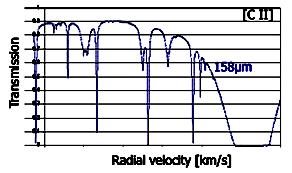 |
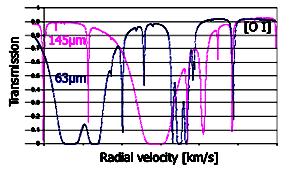 |
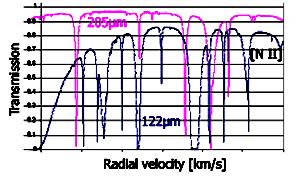 |
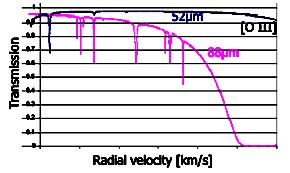 |
Figure 3: Typical atmospheric transmission profiles at SOFIA cruising altitude for some of the important Far-IR fine structure transitions. The radial velocity range in the plots is 0 to 6000 km/s. Three of the graphs show the transmission at the spectral positions of matching pairs of diagnostic lines.
- After the one remaining call for proposals for Herschel observations in summer 2011 FIFI-LS will be the only FIR imaging spectrometer available for a long time. Extrapolating from past statistics, the PACS spectrometer will receive less than 15% of the total observing time of 2000 hours available for the cycle leaving plenty of scientific “spectroscopic real estate” for FIFI-LS.
* Observers trained with PACS certainly want to continue with follow-up observations by fleshing out detections made with Herschel. The similarity of FIFI-LS to PACS is therefore a benefit to SOFIA, since the FIFI-LS observing technique and reduction software are similar to that provided by Herschel. This latter point provides a strong argument for establishing close ties with Herschel/PACS to ensure that FIFI-LS software is similar to PACS. Such a situation then increases the natural synergy that exists between FIFI-LS and PACS.
- Herschel has a limited lifetime and will be winding down at about the time FIFI-LS should become available for community use. The latter implies that many sources will not and cannot be observed with PACS, and others (e.g., extended galaxies) can be observed only partially. Observations with FIFI-LS/SOFIA therefore provide the natural follow-up and extension to studies with PACS/Herschel. (Of course, sensitivity issues will have to be addressed to ensure that such studies can actually be accomplished with FIFI-LS.)
- SOFIA as a returning observatory allows for upgrades of existing instruments. One obvious upgrade of FIFI-LS will be a better match between the instantaneous fields of view between the “red” and “blue” spectrometer channel. See, e.g., Figure 1. With a smaller physical pixel size (e.g., a monolithic array), one could fit more detectors in the “blue” channel and, with an extended/modified IFU, approach the field of view covered by the “red” channel, with a corresponding gain in observing efficiency. The end optics would also have to be modified to adjust the spatial and spectral scales, but this would be possible on the existing optical bench within the instrument.
FIFI-LS on SOFIA will play a major role in investigations of the formation of (primarily massive) stars and the properties of interstellar medium in both our own galaxy and external galaxies. The last topic is one in which FIFI-LS will truly excel. The key features that FIFI-LS will observe in these studies are the bright far-IR fine structure lines, e.g., [O I] 63 and 146 microns, [O III] 52 and 88 microns, [N II] 122 and 205 microns, [N III] 57 microns, and [C II] 158 microns (Table 1). The 63 and 158 micron lines are probably the most important of these:
- They are strong (as they are the major coolants of UV heated gas; the [C II] line for example has a strength on the order 0.1-1% of the total far-IR continuum luminosity in a typical galaxy).
Table 1
|
Blue Spectrometer |
|
Red Spectrometer |
||
|
[OI] |
44.06 µm |
|
|
|
|
[SiI] |
44.81 µm |
|
|
|
|
H2O ice |
45 µm band |
|
|
|
|
[FeII] |
51.30 µm |
|
[FeI] |
111.2 µm |
|
[FeIII] |
51.68 µm |
|
[NII] |
121.9 µm |
|
[OIII] |
51.81 µm |
|
[SiI] |
129.7 µm |
|
[FeI] |
54.31 µm |
|
[OI] |
145.4 µm |
|
[SI] |
56.31 µm |
|
[CII] |
157.7 µm |
|
[NIII] |
57.32 µm |
|
[NII] |
205.2 µm |
|
[PII] |
60.64 µm |
|
|
|
|
[OI] |
63.18 µm |
|
|
|
|
[FII] |
67.20 µm |
|
|
|
|
[SiI] |
68.47 µm |
|
Examples of diagnostic line pairs |
|
|
[FeII] |
87.38 µm |
|
[OIII]: 51.81 µm & 88.36 µm |
|
|
[OIII] |
88.36 µm |
|
[OI]: 63.18 µm & 145.4 µm |
|
|
[AlI] |
89.24 µm |
|
[NII]: 121.9 µm & 205.2 µm |
|
|
[FeIII] |
105.4 µm |
|
|
|
- The combination of the [O I] and [C II] lines provides a measure of the gas density and the strength and hardness of the incident UV radiation in the ISM, photo-dissociation regions (PDRs), and in the accretion disks around Herbig Ae/Be stars (see Figure 5). The geometries of such disks can be constrained, e.g., by observing the 45µm water ice band with FIFI-LS in several settings.
Figure 4: Far-IR spectra of selected galaxies. Emission and absorption lines are indicated. The entire spectral range is accessible with FIFI-LS. From Fischer et al. (1999).
However, all of these lines also provide sensitive diagnostics of the typical conditions of interstellar gas due to the following reasons:
- They are easily excited at the temperatures characteristic of the ISM and PDRs.
- The level populations are determined by collisional excitation with critical densities comparable to the densities typically found in the ISM and PDRs.
- They are optically thin.
- They are relatively unaffected by extinction.
Furthermore, the range of elements and ionization levels available to FIFI-LS observations will allow elemental abundances in the ISM to be estimated. The fact that these lines are relatively immune to the effects of dust suggests that FIFI-LS observations will provide estimates of the physical conditions in heavily dust obscured star-forming regions in both our own galaxy as well as nearby external galaxies and galactic nuclei.
Figure 5: Sensitivity of ISO-LWS (blue curve) compared with FIFI-LS (red).
SOFIA as a stratospheric observatory is still exposed to a thin atmosphere with an average transmission of about 80%. For some of the relevant emission lines Figure 3 provides more detailed atmospheric transmission curves. They demonstrate that all of these fine structure emission lines are readily accessible with SOFIA even for moderately redshifted objects.
With Herschel/PACS observations – and for quite obvious reasons – the predominant efforts have gone in two general directions: full spectral scans of Galactic and (nearby) extragalactic objects, which are possible thanks to the complete absence of Earth’s atmosphere, and observations of objects in the distant universe with deep integrations on a few individual (intrinsically bright) lines. The first class addresses the general theme of star formation and stellar evolution through detailed studies of the chemical and physical processes in the interstellar and circumstellar medium. The second class addresses the history of star formation over cosmic times and, in particular, galaxy evolution (AGN and star formation). Relatively limited amounts of observing time have been dedicated to larger spectral line maps in the nearby universe, Galactic or extragalactic, at least partly due to the high price in observing time for such projects. This is where SOFIA/FIFI-LS, with less observatory overhead, needs to follow up with spatial and spectral scans, not only in external galaxies but also in our own galaxy, filling a gap in our broader knowledge of the “cool universe”.
Figure 6: Ratios of the dominant cooling lines [CII] 158 μm and [OI] 63 μm, and IFIR probe a wide range of gas density, nH, and incident UV radiation, G0. The stars mark the results from some well observed PDRs. The figure is adapted from Kaufman et al. (1999).
FIFI-LS will become the workhorse of SOFIA for several reasons
- Spectra are easy to obtain and to reduce
- Data reduction of PACS and FIFI-LS data is very similar
- Calibration versus the remaining precipitable H2O will become routine
- Pointing will be fast due to the “camera mode” of imaging spectrometers
- Mapping will be fast with SOFIA
- Advanced observing techniques will come into play
- FIFI-LS always obtains both, the line as well as the continuum flux. Obtaining equivalent widths is
then automatic.
FIFI-LS will be capable of making science contributions in nearly every kind of study that SOFIA will be engaged in, but this section is limited to the science that, among the first generation instruments, only FIFI-LS will be able to do:
- Nearby galaxies FIFI-LS will be able to generate maps of external galaxies in the majority of the far-IR fine structure lines, including the dominant [CII] 158 μm coolant line. Such observations will resolve the spiral arms and distinguish emission from the spiral arms from that of the inter-arm regions, allowing detailed studies of the ISM across the arms and investigations into the role of spiral structures in the star formation process. These studies are effective because the line-to-continuum ratios are assured with FIFI-LS. Spectra of a sample of targets (obtained with ISO) are shown in Figure 4.
- Massive star feedback, PDR astrophysics FIFI-LS will cover all the important infrared spectral signatures of photodissociation regions (PDRs). Such diagnostics include the main cooling lines of [CII] 158 μm, [OI] 63 and 146 μm, which can be spectrally mapped by FIFI-LS and compared to Poly-Aromatic-Hydrocarbons (PAH) features, as a way to link the presence of PAHs to PDR physical conditions (Figure 6).
|
|
 |
 |
Figure 7: Upper left: M83 (© AAT) is a prototypical starburst galaxy seen almost face-on. Upper right: The 7 µm ISOCAM image shows details at a resolution comparable to what SOFIA will achieve at 30 µm wavelength. Overlayed is the FIFI-LS 5x5 pixel grid for the red arm. The grid for the blue arm would only be half that size. Lower left: The [CII] 157 µm line emission map obtained with FIFI at the KAO on M83. A similar map with FIFI-LS at SOFIA would have an angular resolution about 3 times better.
- Giant planets FIFI-LS will give disk-integrated spectral energy distributions (SEDs) for Uranus and Neptune and it can distinguish between different hemispheres of Jupiter and in the shorter wavelength also of Saturn. With this information one can determine the He/H2 ratio, constrain the ortho-para ratio of H2 (which traces atmospheric dynamics), and provide temperatures over a limited vertical range in the atmospheres of Uranus and Neptune. In Jupiter and Saturn, however, this capability is affected by the dominance of ammonia and phosphine, respectively, in the wavelength range of FIFI-LS. Note that the atmosphere of Saturn is very depleted in helium compared to the Sun and the other Jovian planets, because of He exsolution from metallic hyrodgen at very high pressures and low temperatures.
- Transient and variable sources Due to SOFIA’s flexibility and the nature of transient events, FIFI-LS will be an important instrument for sources of unpredictable nature like novae or supernovae, or for variable bright AGN and X-ray sources or transient sources that are extended such as comets. Also transits of exoplanets can be observed to explore the nature of the exoplanetary bodies, their mass, their densities, debris rings as well as their atmospheres and also features on the stellar surfaces.
- Identification of PAHs Spectroscopic studies in the 20-500 μm region could eventually lead to unique identification of a PAH molecule, with the 100-200 μm of prime importance due to the presence of distinct and somewhat isolated bands in that wavelength region. FIFI-LS has the appropriate combination of spectral resolution and sensitivity required to detect and resolve suitable lines.
FIFI-LS is about twice as sensitive as ISO-LWS across the FIR wavelength range. FIFI-LS will be able to study early to mid evolution of starbursts in external galaxies using FIR fine structure emission lines. While starburst phenomena can be studies in different wavelength regimes, UV to NIR studies will be sensitive to extinction. Far-IR and radio continuum emission, on the other hand, also traces all stages of embedded evolution (on timescales <1 Myr) due to reprocessing of UV radiation by dust, but may be affected by AGN and post-starburst emission. FIR lines are virtually unaffected by interstellar dust extinction (t~10-24•NH) and are therefore ideally suited for investigation of heavily obscured regions in nearby galaxies. New discoveries are being made. Very recent CARMA observations by Alatalo et al. 2011, e.g., of NGC 1266 reveal ~109 solar masses of molecular gas within 100 pc of the nucleus, a molecular mass concentration about 100 times higher than in our own galaxy, making it an excellent candidate for AGN feedback.
1. One of the major observational programs that can be carried out with FIFI-LS will be mapping the entire face of nearby galaxies in these fine-structure lines, with the goal of separating the emission from the spiral arms from that of the inter-arm regions. The spatial resolution afforded by SOFIA will allow such a program to study how the conditions in the ISM vary across the spiral arms, which in turn provides information on the role that spiral arms play in the star formation process and the interaction between newly formed massive stars (formed in the arms) and their natal clouds/ environments. Similar arguments also apply for other regions within such galaxies (e.g., circum-nuclear or cicum-bar star formation). The FIFI-LS sensitivity will allow observation of many different Hubble types of nearby galaxies.
Figure 8: Many low-metallicity galaxies show an unusually bright [CII] 158µm emission line (Madden 2000)
The mid-IR image of the prototypical nearby starburst galaxy M83 (Figure 7 upper right) shows that the arm/interarm contrast is well discernable and the spacing of the FIFI-LS spatial grid is well matched to resolve star formation regions. At an assumed distance of 4.6 Mpc the blue grid of 6” spacing corresponds to a linear pixel of 140 pc, while the red grid corresponds to 280pc, respectively. The KAO 158 µm line image, obtained with the KAO (Madden et al. 1993, Geis et al. in prep.), shows already extended and structured emission, which will be improved upon by FIFI-LS.
The Seyfert 1 galaxy NGC 1097 displaying a bright starburst ring has been observed with the PACS spectrometer by Beiroa et al. (2010). Their average nuclear flux in the [OIII] 88µm emission line obtained within about 40 minutes on-source integration time is 6.6•10-17W/m2/pixel (see Figure 9). Observing the same region with FIFI-LS also with 40 minutes on-target observing time and using the listed FIFI-LS blue channel sensitivity (4•10-17 W/m2/pixel in 15 minutes) will yield a S/N of ~11. This calculation demonstrates that for bright nearby targets, FIFI-LS can observe on a similar time-scale compared with the PACS spectrometer.
Figure 9: PACS spectrometer maps of the nuclear [OI] and [OIII] emission of NGC 1097. The average line flux emission in the [OIII]88µm map of the starburst ring s about 0.3•10-17W/m2/sr. For details see text. (From Beirao et al. 2010)
2. Another topic in this context are dwarf galaxies, which typically have not encountered episodes of massive star bursts, although some of them like, e.g., He 2-10, do go through starburst phases. Dwarf galaxies are not as dusty as their more massive siblings, but they generally show signs of extinction, e.g., LMC or NGC6822. Would dwarf galaxies have been involved in a merger event they would have been destroyed already. Due to their reduced pace of star formation, many of the dwarf galaxies are low-metallicity laboratories, which could serve as a model for lower metallicity environments in the early universe. Metallicity has strong effects on physical conditions observed in the small sample available to date based on KAO and ISO observations (Figure 8). FIFI-LS will allow observations spanning a wide range in metallicity in the major FIR lines to probe conditions of such star formation.
Figure 10: Violent star formation in the Antennae galaxy as traced by ISOCAM (upper left, Vigroux et al.1996) and the [CII] 158µm line (lower left, Madden et al.1993). The host of activity is obscured in the visible (right). FIFI-LS at FIR wavelength will spatially resolve the star burst in many spectral FIR lines. The blue pixel grid of FIFI-LS with a spacing of 6" per pixel corresponds to 600pc at the location of the galaxy.
3. A high fraction of ultra-luminous infrared galaxies (ULIRGs) are colliding and merging galaxies. In these cases violent star formation seems to be triggered by external disturbances due to direct collision of molecular clouds, infall of matter due to transfer of angular momentum, or non-symmetric gravitational potential, bar-triggered steady flow of matter or the like. Nearby interacting galaxies like the Antennae are excellent laboratories for studying the aftermath of galaxy collisions and their resulting impact on massive star formation (see Figure 10). So far, no observations have been executed on the Antennae with the PACS spectrometer.
 |
 |
Figure 11: Heating and cooling mechanisms in a typical PDR as a function of optical extinction (Tielens & Hollenbach 1985).
The center of our Galaxy is about 100 times closer than the nearest large galaxy and about 1000 times closer than the nearest active galaxy. The Galactic Center is known to host a 3.5×106 solar mass black hole (Schödel et al. 2003, Ghez et al. 2005, Genzel et al. 2010), has signs of AGN activity (and luminosity) as recently as a few hundred years ago (Revnivtsev et al. 2004), and has strong evidence for massive star formation within the last few million years (e.g. Najarro et al. 1997, Krabbe et al. 1995, Bartko et al. 2010, Yusef-Zadeh et al. 2010).
The stage for this puzzling plethora of phenomena is set by a complex environment in terms of the interstellar medium, both ionized and neutral gas components, and the interstellar radiation field (e.g. Serabyn & Lacy 1985, Jackson et al. 1993, Lutz et al. 1996, White et al. 1999). The mid- to far-infrared offers a set of highly diagnostic lines to trace and characterize these different components, but earlier observations from the KAO and ISO lacked the necessary spatial resolution to separate the individual regions of different physical conditions, all contained within the ~1 arcmin molecular ring surrounding SgrA* (e.g., Zhao et al. 2009), and therefore often blended within one beam/aperture. At this time of writing no observations with PACS spectrometer exists for these regions of the Galactic Center.
With FIFI-LS on SOFIA one can bring the resolution of e.g. the [Ne II] observation of Serabyn & Lacy (1985) to the far infrared and, thus, separate (or relate) the ISM components. The final goal of such a study is a deeper insight into the material transport and the conditions for (and created by) massive star formation in the neighborhood of SgrA*. Missing most in this context is a spatially resolved map of a higher-excitation tracer, to complement maps of dust, neutral gas, and lower excitation ionized gas within the central cavity. What is mostly needed are maps of an area of 2' × 2' around SgrA* in the 52 μm and 88 μm [O III] lines and maps of the same area in the 158 μm [C II] and 145 μm [O I] lines.
Photon-dominated regions or photo-dissociation regions (PDRs) are the transition regions between an HII-region and a molecular cloud (eg. Hollenbach & Tielens 1999). PDRs are found in all high-mass star-forming regions where the young massive stars ionize their immediate surroundings while still being (partly) embedded in their parental molecular cloud. In the HII-region, hydrogen, carbon, and oxygen are all ionized. In the molecular region, these elements are found as H2 and CO. Where the transition from the ions over atoms to molecules occurs, depends on the optical depth of the UV radiation penetrating the molecular cloud (Figure 12). The clumpiness of the interstellar material has to be taken into account, too, as models of PDRs show (eg. Gorti & Hollenbach 2002, Röllig et al. 2007). Compared to a homogeneous model, clumps allow the hard stellar radiation to penetrate deeper into the molecular cloud and create larger areas of interface layers on it.
The energy deposited into the PDR by the UV photons from the star is radiated away in the dust continuum and as far as the gas is concerned prominently in FIR fine-structure lines. These bright fine-structure lines are the main cooling-lines and are responsible for substantial fractions of the total energy radiated away (Figure 11). The intensity of these lines depends on the abundance of the emitting species and the density and temperature of the emitting regions. Since a few species emit in two fine-structure lines, the line ratio is insensitive to abundance. Such line ratios are very handy diagnostics to derive the temperature and densities within a PDR (Tab. 1). But also abundances and the intensity of the UV radiation field can be derived. And all these FIR diagnostics are largely unaffected by dust extinction which obviously can be large towards PDRs.
But with FIFI-LS, we cannot only observe the lines and measure their ratios, but also map PDRs efficiently over a large area. Immediately, we have temperature and density gradients from the HII region into the molecular cloud. Combined with continuum observations and knowledge about the exciting sources, one can derive a detailed energy budget of the region. The physical changes of the gas and the radiation field in and along the interface are readily observable. The process of the massive star(s) eroding the molecular cloud away can be studied in detail with the unprecedented spatial resolution FIFI-LS can offer.
Figure 12: The NW and S PDRs of NGC 7023 observed by Spitzer-IRAC at 8μm (red) and 3.6μm (green). The white circle represents the HIFI beam at 535GHz (41”) towards the H2 peak. The dotted lines show the cuts that are studied in the [CII] emission line at 158μm with a beam of 11”. The star position is shown with a black cross (Joblin et al., 2010). The footprints of both FIFI-LS arrays are shown, too.
For example the large Orion region, the closest massive star forming region including a PDR seen edge-on (Tielens et al., Science 262, 86, 1993), can be mapped at a resolution of 0.01 pc, which allows to trace the changing excitation and gas conditions from the BN/KL-region across the Trapezium cluster and into the bar. This 5’x5’ region can be mapped with FIFI-LS in the [CII]-line and the [OI] and [OIII] line pairs (5 lines altogether) in less than two hours reaching a SNR > 100.
Recently, Joblin et al. 2010 observed the well studied PDR NGC 7023 with Herschel/HIFI along two cuts (shown in Figure 12 as white dashed lines) in the [CII] 158mm line and found fluxes of a few
10-7Wm-2sr-1. FIFI-LS would be able to map NGC7023 in this transition and one other transition in about 10 minutes with a SNR > 50. Herschel/PACS observed this PDR also in [OI], but FIFI-LS will be able to provide a higher angular resolution map at shorter wavelengths and additional transitions with its more efficient mapping capabilities in a shorter time.
Alatalo et al. 2011, Bull. AAS, 217, #335.08
Bartko et al. 2010, ApJ, 708, 834
Beiroa et al. 2010, A&A, 518, L60
Fischer et al. 1999, Ap&SS, 266, 91
Genzel et al. 2010, RvMP, 82, 312
Ghez et al. 2005, ApJ, 635, 1087
Gorti & Hollenbach, 2002, ApJ 573, 215
Hollenbach & Tielens1999, Rev. Mod. Phys. 71, 173
Jackson et al. 1993, ApJ, 402, 173
Joblin et al. 2010, A&A 521, L25
Kaufman et al. 1999, Apj, 527, 795
Krabbe et al. 1995, Apj, 447, L95
Lutz et al. 1996, A&A, 315, 269
Madden et al.1993, In proc. of NASA. Ames Research Center: The Evolution of Galaxies and Their Environment, p 185-186
Madden 2000, NewAR, 44, 249
Najarro et al. 1997, A&A, 325, 700
Revnivtsev et al. 2004, A&A, 425, L49
Röllig et al. 2007, A&A 467, 187
Schödel et al 2003, ApJ 596, 1015
Serabyn & Lacy 1985, ApJ, 293, 445
Tielens & Hollenbach 1985, ApJ, 291, 722
White et al. 1999, A&A, 342, 233
Yusef-Zadeh et al. 2010, ApJ, 725, 1429
Zhao et al. 2009 ApJ, 699, 186
FIFI-LS underwent a science review sponsored by DLR in order to assess the current scientific stand of the instrument.
Here follow some of the findings of the Review committee:
(1) There will be very interesting and important science to do with FIFI-LS, both on extended Galactic objects like e.g. photo-dissociation regions and the Galactic Center region, and on nearby extragalactic systems. Herschel/PACS will have studied only a fraction of these.
(2) After the de-commissioning of Herschel, and before the (not yet approved) SPICA mission with the SAFARI instrument becomes operational, i.e. during the period 2014 to at least 2020, FIFI-LS will be the only instrument of its kind that is available.
(5) The Review Board has been informed about and appreciates the considerable effort that the University of Stuttgart has made to provide adequate laboratory and office space for all FIFI-LS related activities, including special investment into infrastructure that is needed to handle an instrument like FIFI-LS.
(8) In conclusion, being convinced of the quality and scientific potential of the FIFI-LS project, the Review Board considers it fully justified and strongly recommends that the DLR continues its support of the FIFI-LS related activities at least at the previous level. In view of the tasks at hand, the Review Board would recommend an even somewhat higher level of funding if the University of Stuttgart would make a similar effort to enhance its own support. The scientific and technical benefit to the University, last but not least to the graduate students, who will be involved in the FIFI-LS project, will be very high. It is a unique opportunity!
Contact
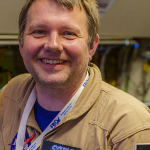
Christian Fischer
Dr.-Ing.DSI FIFI-LS


